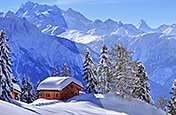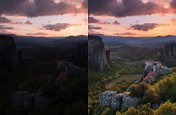Jump to light speed with star trail photography.
Explore how to shoot stunning views of the heavens and show distant suns streaking across the night sky to create star trails.
Video by Jared Tamez
What is a star trail image?
Star trail photos are a type of astrophotography that focuses on the paths starlight creates in the night sky over a period of time. With a long exposure time, a camera trained on the night sky will catch the arcing trails of light from stars as the earth rotates, leaving circles of light on the image.
With the time-lapse technique, you can take periodic shots of the same scene using longer exposures that keep a camera sensor exposed to light for 30 minutes — or even shorter four-minute-long exposures. Then you can merge this series of images in Adobe Photoshop to capture hours’ worth of star movement.
“Star trail photography is a unique way that photographers can capture the skies in a way that our eyes just aren’t able to,” says photographer Jared Tamez. “It gives us a perspective of the night sky and how it relates to the rest of the world on the ground. It offers a unique creative lens that allows the skies to frame landmarks we see every day in a new light.”
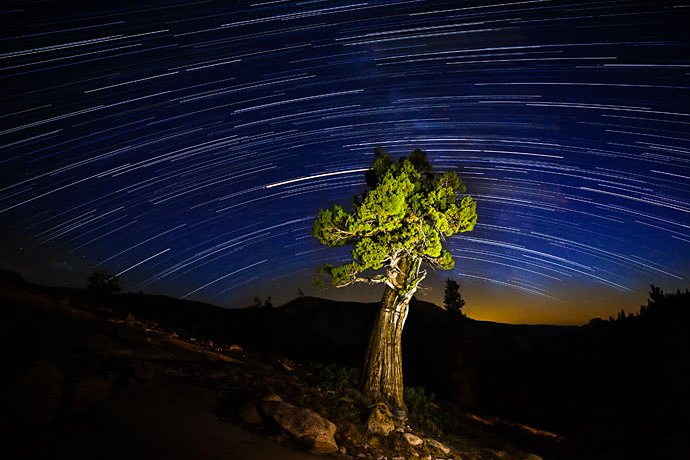
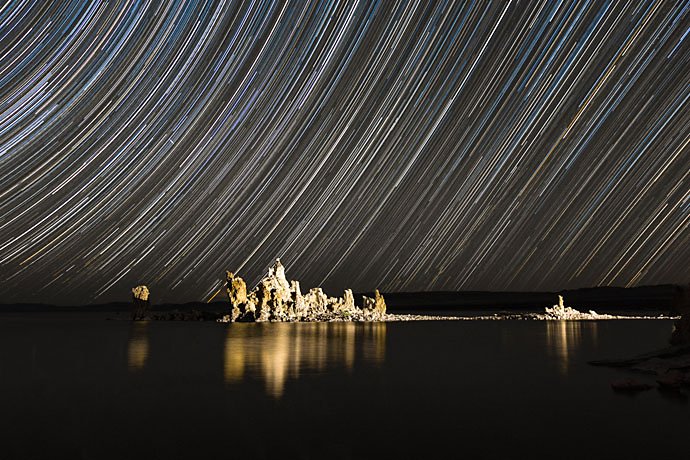
Images by Beth Young
Work on those night moves.
Start with the basics of night photography when it comes to any form of astrophotography. The amount of light that hits your camera sensor determines how your images turn out. Longer shutter speeds are required to get enough light at night. And ISO, which controls the sensitivity of your camera sensor to light, is also key. A high ISO allows your camera to capture more light in dark scenes.
“The basics of nighttime single-exposure photography are foundational. If you can take one nighttime image, you can figure out a way to take 200 and put a star trail image together,” says Tamez. “Learn the settings in manual mode and learn how to focus your lens on the stars since autofocus doesn’t work well at night.”
But those are just the basics. Long shutter speeds and higher ISOs mean you’re more likely to take blurry images if there is any camera shake or movement. For night sky, Milky Way, and star trail photography, you’ll need a tripod to keep your camera steady for long periods of time. You’ll also want to use a remote shutter or cable release since even pushing your shutter button can blur your shots.

Follow the stars.
It’s a good idea to research weather conditions, timing, and locations before shooting star trails. Here are a few things to consider to maximize your ability to capture the night sky.
Clear skies, lights out, can’t lose.
Light pollution can kill good star trail photos before you even begin. To get the best shots, whether you live in a big city or a small town, you’ll want to escape the glow of neon signs or even the street lights of a quiet suburban neighborhood. Online light pollution maps can show you how far you need to drive for the best conditions.
Even in the wilderness, the full moon can be a competitive light source that complicates your shots. A new moon, when the moon reflects no sunlight, is ideal when you want dark skies.
Be sure to check the weather report before you jump in the car. Cloudless skies are essential to capture good night sky shots, and you don’t want to fight against the wind to prevent camera movement.
While you can capture star trail shots anywhere it’s dark enough, remember that the positions of the stars shift based on the season. And how they sit in the night sky will vary depending on your latitude. They also differ in the southern or northern hemisphere. Star maps for the location you plan to shoot from will help you set up your shots.
“Learning to find Polaris, the North Star, became very important for me,” Tamez explains. “Especially in images where you see the concentric circles, you have to know where Polaris is to position that in the shot.”
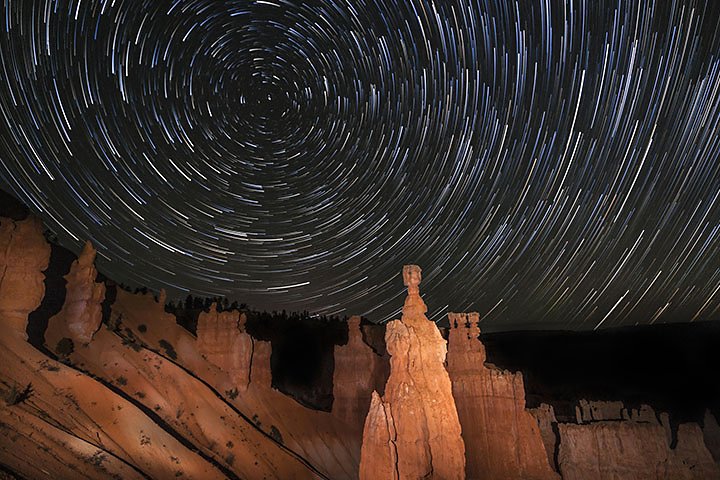
The south and north celestial poles are fixed spots in the night sky above the gravitational poles of Earth — they correspond to where the planet rotates, not to any specific star, just a section of sky. While you can focus on any star or section of sky, knowing these points (and the locations of different constellations and stars) gives you the bearings and orientation you need to explore the heavens with your camera.
Once night falls in the rural areas where you’ll shoot star trail photos, it gets dark. For safety reasons, it’s best to get to your location before nightfall — you don’t want to trip on a rock and ruin your shot or even damage your camera. And you don’t want to spend hours trying to capture star trails that frame a mountain only to learn the next day that you didn’t have the peak in frame.
Adjust camera settings, set up your tripod, and get your composition right before you lose the light after the sun goes down.
Gear up for star trail shots.
Tripod
It’s essential to keep your camera steady during long exposure shots and time-lapses — two techniques that are key to crafting star trail photos. A good tripod ensures your camera captures a series of images that you can merge in post-processing.
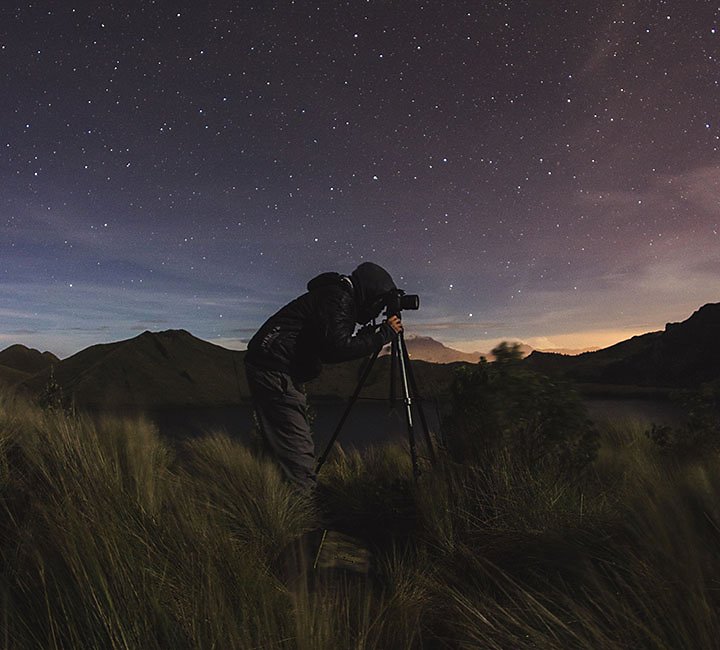
Intervalometer
While a single long-exposure shot can capture some star movement, many types of star trail photos require continuous shooting over a long period of time. Intervalometers allow you to turn on a timed shutter release on your camera at a set interval.
Many cameras have a built-in intervalometer, but you can buy one as an attachment as well. Depending on your intervalometer, you can set it up to capture a shot from as short as every second to as long as every few hours.
You’ll need some light to work in the dark environment required to capture star trail photos. Attaching a glow stick to your tripod can be handy so you don’t accidentally bump into it in the dark. A headlamp, especially one with a red light that your eyes can adjust to more quickly (and isn’t bright enough to affect your shots) is a great way to make sure you can see what you’re doing.
“A wide-angle lens is preferred,” recommends Tamez. “You can get a broad look at the sky and also include some interesting foreground elements if you want to, which often helps to make the image more intriguing.”
Long exposure vs. short exposure times.
Whether you use a DSLR or mirrorless camera, there are two main techniques for star trail images, and the difference between them comes down to exposure time. You can either capture star trails in a single long exposure or stack a series of short exposure shots into a single image.
Leave your camera shutter open for an extended amount of time to capture long exposure images — they can capture minutes’ to hours’ worth of stars moving across the night sky. “At a minimum, I think the least that I’ve done is 34-minute exposures,” photographer Beth Young explains. “Letting it go for at least an hour and a half to two hours is even better. But if you have the patience and the time to do it longer than that, I would recommend doing it longer.”
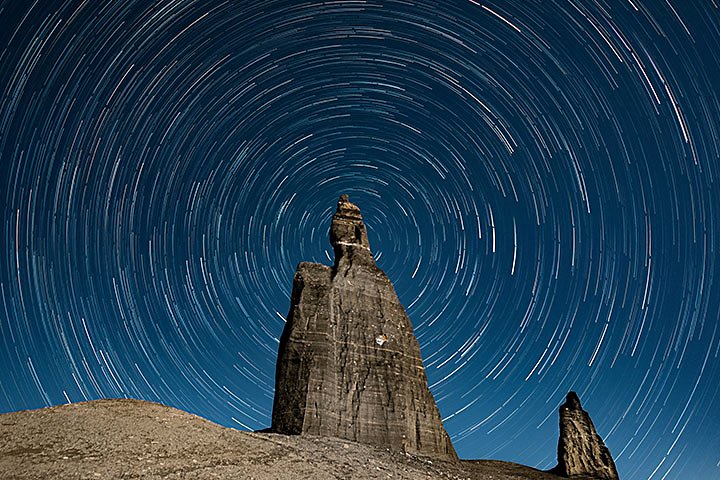
Image by Jared Tamez
With long exposures, you’ll have to be extra careful of any camera movement. You can easily ruin a single shot with a bump to the tripod. And, since more light will hit your camera sensor, you may have to do some long exposure noise reduction in editing.
Create short exposure star trail images with a series of shorter night sky shots, like hundreds of 30-second exposures. Place them on top of each other to make one single image of the stars’ movement over the course of all your shots. Akin to a time-lapse, you capture dozens or hundreds of images during a night and then merge them together.
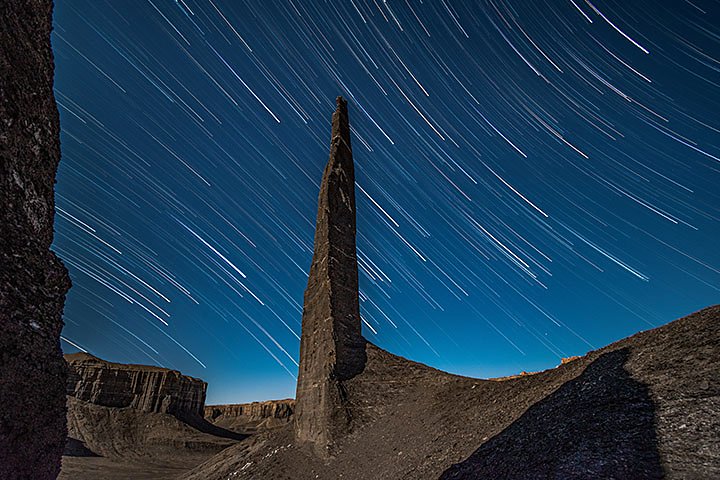
Image by Jared Tamez
“I tend to do four-minute exposures at ISO 400 with an f-stop of f/4,” Young says. You can adjust the timing between intervals, but shorter intervals have a few benefits. “Shorter intervals allow you to preserve the pinpoint nature of the stars and star patterns in each image,” explains Tamez. “Not only will that help you with the time-lapse, but it’ll help you with any stills that you might want to take from the session.”
Before you let your camera take a series of dozens — or even hundreds — of photos over the course of hours, make sure to take a test shot or two with manual focus and settings adjustments. You want to make sure your settings are correct first so you don’t end up with a ton of unusable images in post-production.
Bring your stargazing into the editing booth.
With Adobe Photoshop Lightroom, you can quickly organize all your star trail shots — of which there may be hundreds, depending on which technique you used. For a single long exposure shot, Lightroom offers a number of adjustment sliders to fine-tune any single image, reducing exposure, increasing brightness, or adjusting the hue and saturation as needed. Save and sync your Lightroom edits before you move them to Photoshop for further editing.

To merge a series of shots into a single image, you’ll want to bring your images into Photoshop to stack them. “When I get home, I import into Photoshop, and then I’m able to make those images separate layers and do a blend.”
In a process very similar to focus stacking, you’ll export all your selected images from Lightroom to Photoshop as layers, using the first shot as your bottom layer. Then lighten the opacity of every layer after that to create your final image from a series of night sky shots.
Kermit the Frog once asked, “What’s so amazing that keeps us stargazing?” And while understanding how to capture star trail photos might not deliver an answer to that philosophical question, it will certainly help you create beautiful images for audiences to appreciate as they ponder the intriguing night sky.
Contributors
Do more with Adobe Photoshop Lightroom.
Edit photos easily with Lightroom presets, Super Resolution, easily share photos from any device and access your projects anywhere with cloud photo storage management.
You might also be interested in…
Adjusting white balance settings to improve photos.
Understand white balance and how to enhance the look of images using color balance tips.
Discover ways to select the ideal focal length for any and every photo.
Sharpen your photos and get correct exposures by using the histogram tool.
Learn to use histograms to reduce the noise and enhance the details in your photos.
RAW vs. JPEG: Which format should you shoot in?
Dive into the differences between photographs taken in RAW and JPEG format.
